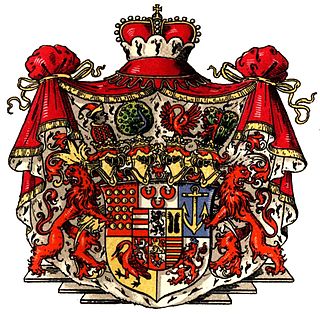
Bentheim-Tecklenburg-Rheda was a historical county of the Holy Roman Empire, located in present northwestern North Rhine-Westphalia and southwestern Lower Saxony, Germany.

Bentheim-Steinfurt was a historical county located in northwestern North Rhine-Westphalia in the region surrounding Steinfurt, Germany. Bentheim-Steinfurt was a partition of Bentheim-Bentheim, itself a partition of the County of Bentheim. Bentheim-Steinfurt was partitioned: between itself and Bentheim-Tecklenburg-Rheda in 1606; and between itself and Bentheim-Bentheim in 1643.

Bentheim-Tecklenburg was a German county based in the region around Tecklenburg in northern North Rhine-Westphalia, Germany.

The County of Bentheim was a state of the Holy Roman Empire, located in the south-west corner of today's Lower Saxony, Germany. The county's borders corresponded largely to those of the modern administrative district (Landkreis) of Grafschaft Bentheim.
The table of years in art is a tabular display of all years in art, for overview and quick navigation to any year.

Frederick of Anhalt-Harzgerode, was a German prince of the House of Ascania and the first ruler of the principality of Anhalt-Harzgerode.

Arnold III of Bentheim-Tecklenburg-Steinfurt-Limburg was a German nobleman. He was Count of Bentheim, Tecklenburg and Steinfurt, and jure uxoris Count of Limburg. He ruled as Arnold IV in Bentheim and Tecklenburg, and as Arnold II in Steinfurt. In Limburg, he was the first Count named Arnold and hence just the name distinctive.

Bentheim Castle is an early medieval hill castle in Bad Bentheim, Lower Saxony, Germany. The castle is first mentioned in the 11th century under the name binithem.

The House of Bentheim is one of the oldest extant German noble families. They are a mediatized family, formerly being rulers of their own territories directly under the Holy Roman Emperor. They belong to both the ancient nobility (Uradel) and the high nobility (Hochadel). Today, there are two main lines of the family: the princes of Bentheim-Steinfurt and the princes of Bentheim-Tecklenburg. There is also a third, non-princely line of the family, the counts of Bentheim-Tecklenburg-Rheda.

The County of Steinfurt, originally the Lordship of Steinfurt, was a historic territory of the Holy Roman Empire in the Munsterland. It existed from roughly 1100 until 1806.






